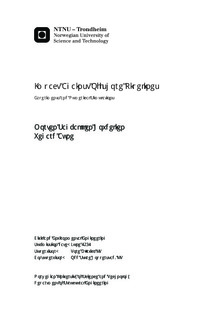| dc.contributor.advisor | Børvik, Tore | nb_NO |
| dc.contributor.advisor | Hopperstad, Odd Sture | nb_NO |
| dc.contributor.author | Aune, Vegard | nb_NO |
| dc.contributor.author | Hovdelien, Morten Sagbakken | nb_NO |
| dc.date.accessioned | 2014-12-19T12:00:31Z | |
| dc.date.available | 2014-12-19T12:00:31Z | |
| dc.date.created | 2012-11-08 | nb_NO |
| dc.date.issued | 2012 | nb_NO |
| dc.identifier | 565966 | nb_NO |
| dc.identifier | ntnudaim:8082 | nb_NO |
| dc.identifier.uri | http://hdl.handle.net/11250/236959 | |
| dc.description.abstract | In the present thesis impact against offshore pipelines was studied. Incipient fracture in the pipes after impact was of special interest. The present work was a continuation of previous theses on the subject, and part of an ongoing research program between SIMLab (NTNU) and Statoil ASA.Component tests and numerical simulations using ABAQUS/Explicit and LS-DYNA were carried out to investigate the problem. Two pipes were impacted at different velocities in the pendulum accelerator at the Department of Structural Engineering, NTNU. The most exposed regions were investigated metallurgically to examine the material behavior at large deformations due to the impact.Pre-compressed notched tension tests at large compressive plastic strains (up to 40 %) were conducted. A material model with combined kinematic and isotropic work-hardening was calibrated based on the material tests. Inverse modeling was carried out with the optimization tool LS-OPT. In addition, the material model consisted of an uncoupled fracture criterion. The combined material model was used in the numerical simulations.The material tests revealed a distinct Bauschinger effect, transient and permanent softening, as well as a work-hardening stagnation during reversed loading. Simulations of the material tests in ABAQUS/Explicit corresponded well with the experiments. However, simulations of the pipe in ABAQUS/Explicit revealed little improvement regarding the global response compared to previous theses. Further, the volume element model in LS-DYNA revealed hydrostatic tension in the critical element during rebound, where incipient fracture was assumed to appear. This was supported by metallurgical investigations revealing a crack through 75 % of the thickness after impact at the highest velocity. It is clear that this decreases the strength of the pipes. Hence, cracks will propagate through the thickness earlier than expected during stretching in the simulations. This indicates that the single-parameter assumption regarding the fracture criterion used in this thesis ceases to be valid for the component test. To recreate the fracture in the impacted pipes an additional formulation must be included. | nb_NO |
| dc.language | eng | nb_NO |
| dc.publisher | Institutt for konstruksjonsteknikk | nb_NO |
| dc.subject | ntnudaim:8082 | no_NO |
| dc.subject | MTBYGG Bygg- og miljøteknikk | no_NO |
| dc.subject | Beregningsmekanikk | no_NO |
| dc.title | Impact Against Offshore Pipelines: Experiments and Numerical Simulations | nb_NO |
| dc.type | Master thesis | nb_NO |
| dc.source.pagenumber | 199 | nb_NO |
| dc.contributor.department | Norges teknisk-naturvitenskapelige universitet, Fakultet for ingeniørvitenskap og teknologi, Institutt for konstruksjonsteknikk | nb_NO |

